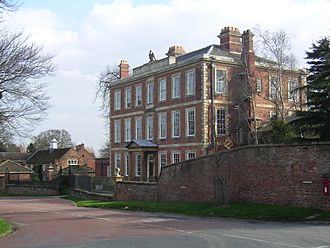Middlethorpe Hall facts for kids
Quick facts for kids Middlethorpe Hall |
|
|---|---|
 |
|
| General information | |
| Location | Bishopthorpe, York |
| Coordinates | 53°55′50″N 1°05′24″W / 53.93060°N 1.08998°W |
| Owner | National Trust |
|
Listed Building – Grade II
|
|
| Designated | 14 June 1954 |
| Reference no. | 1259554 |
Middlethorpe Hall is a large country house built in the 1600s. It sits on 20 acres of land in Middlethorpe, near York, England. Today, it is a hotel.
This beautiful house was built in 1699. It has red bricks and stone, and both sides are exactly the same. Since 2008, The National Trust has owned it.
Contents
About Middlethorpe Hall
The house is quite close to the road. This was a bit unusual for such a grand building back then. Its design was inspired by famous architect Sir Christopher Wren. It looks a bit like Hampton Court Palace. It has red bricks, white windows, and stone corner blocks.
The front of the house, facing north, has seven sections and three floors. Above the front door, there is a stone eagle. This eagle is the Barlow family crest. The fancy porch over the door was added in the early 1800s. The curved fences and gates around the front yard were put in place in 1983.
The Main Side of the House
The south side is the main part of the house. It has a raised stone wall with carvings of flowers and fruits. Another stone eagle sits on top. This side looks even grander because of the extra sections added in the mid-1700s. These single-story additions have columns with detailed tops.
Inside the Hall
When you enter, you step right into a stone-floored hall. This is like how medieval houses were built. Further inside, there is a beautiful oak staircase. It has carved balusters, which are a common design in York. The stairs are supported by a Corinthian column. The floor is made of black and white marble squares.
There is a panelled drawing room that leads to a huge ballroom. This ballroom is in one of the wings added around 1750. The dining room is from the original time the house was built. It has round panels with Ionic pilasters (flat columns).
History of Middlethorpe Hall
Middlethorpe Hall was built around 1699 to 1701. It was built for Thomas Barlow. He was a very successful cutlery maker. He bought the Middlethorpe land in 1698. He wanted to become a country gentleman.
Early Owners and Visitors
In 1712, Thomas Barlow and his son Francis went on a long trip around Europe. While they were away, they rented the house to Lady Mary Wortley Montagu. Francis Barlow later held an important local role. He was the High Sheriff of Yorkshire from 1734 to 1736.
The house stayed in the Barlow family for many years. It passed down to Frances Barlow. She married a doctor named Matthew Alexander Eason Wilkinson. Frances died young, but her husband and his second wife lived at the hall. They had six children there. The gardens at Middlethorpe Hall are said to have inspired their daughter, Fanny Wilkinson. She became Britain's first professional female landscape designer.
Changing Uses of the Hall
For most of the 1800s and early 1900s, the Wilkinson family owned the house. However, they often rented it out to different people. From 1851, it was a girls' boarding school for 30 years. Later, in 1972, it even became a nightclub called "Brummels."
In 1980, a company called Historic House Hotels bought the hall. They worked hard to improve and restore the grounds and other buildings. They planted hundreds of trees. They also added a ha-ha (a hidden ditch) and a lake. An old dovecote (a building for doves) from the 1600s was fixed up. The kitchen garden was replanted. The old stable buildings were changed and made bigger to add more hotel rooms.
Becoming a National Trust Property
The Hall and its grounds were later given to the National Trust. This was a gift from the directors of Historic House Hotels (HHH). The hall still operates as a hotel under the same management. Three directors from the National Trust joined the HHH board. All the money the hotel makes now goes to the National Trust. This helps pay for the long-term care of the house.
This gift had been discussed for almost 30 years. In 1997, the National Trust agreed to rules about the property. The National Trust officially took over the Hall in September 2008. They made sure the Hall and two other properties would be protected forever.
The plan is for the gardens and grounds to be open for visitors. People will also be able to take tours of the ground floor rooms. Members of the National Trust are welcome to stay as hotel guests. The general public is also welcome.

